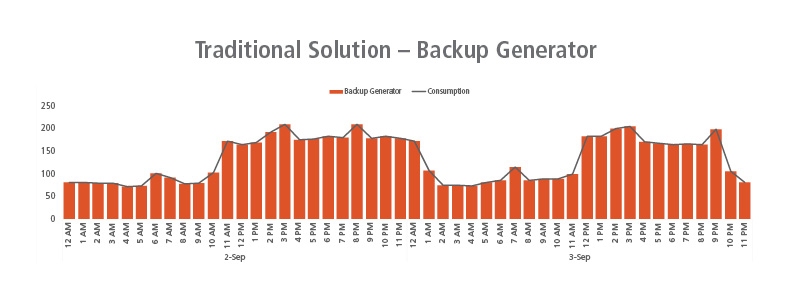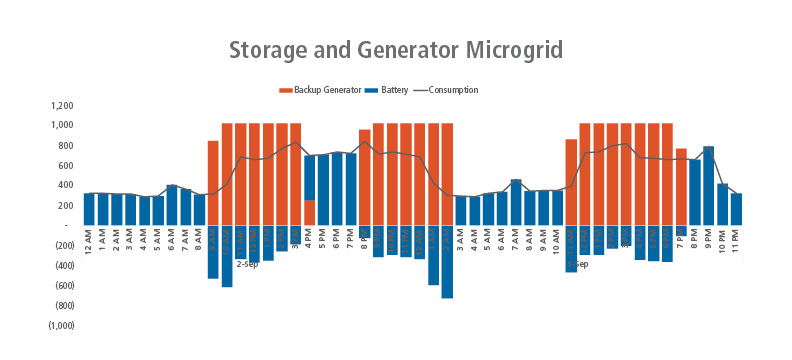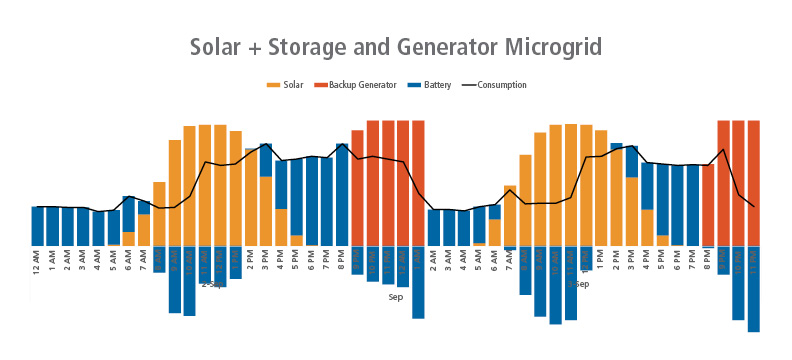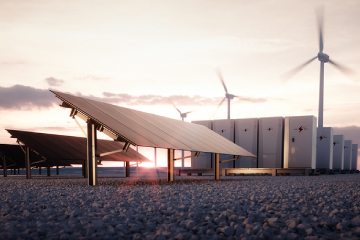- About UsAbout UsWe’re committed to providing future generations with the means to power their lives in the most economic, environmental and socially responsible ways possible.
- What We DoWhat We DoWe are a market-leading, independent power producer and service provider, delivering: wind (onshore and offshore), solar photovoltaic, storage, and electrical vehicle charging.
- Landowners
- Suppliers
- Projects
- Careers
- News
- Contact
Improve the Resiliency of your Operations with a Microgrid

EDF Renewables North America
In recent years, extreme weather events have resulted in power outages of increasing frequency, power, and duration across the country, driving up the cost of electricity and demonstrating the fragility of the utility grid. This situation is perhaps felt most acutely in California, where heatwaves, aging infrastructure and an increasing number of severe wildfires have resulted in rolling blackouts and extended power outages. These include public safety power shutoff (PSPS) events in which utilities intentionally turn off power to millions of their customers.
A report from utility research firm E Source found that U.S. businesses lose more than $27 billion a year due to power outages, and even outages that only last a few hours can cost businesses an average of $10,000 to $20,000 per event.[1] A different survey found that 19% of commercial and industrial customers experienced a financial impact of $50,000 or more per outage, and for another 18%, outages cost $50,000 or more per incident.
If your organization requires emergency power to protect your products and services and ensure continuity of operations, your facility likely already relies on one or more gas or diesel emergency generators – and chances are that this system costs a lot more than it should because the fossil fuel-only approach to backup power is outdated and inefficient.
Microgrids are innovative, state-of-the art systems that integrate traditional emergency generators with batteries, renewable generators, and intelligent componentry to create a sophisticated, resilient system that improves efficiencies, reduces fuel consumption, lowers GHG emissions and saves money.
Go from relying on backup power to having your own private island
Emergency backup generators were a suitable solution when power outages were few and far between. Today, outages are quickly becoming a semi-regular occurrence of increasing duration, and proactive organizations are responding by developing resiliency strategies designed for this new environment. As the name suggests, microgrids are miniature power networks that reduce a facility’s electricity bills when connected to an operating utility grid, but when necessary are also capable of operating as “islands” that are disconnected from the grid. This allows them to seamlessly provide full power to the facility as if the grid were still there, with no discernable interruption to your operations or activities.
Hardworking assets that pay for themselves
Standalone emergency generators don’t produce any benefits when they’re sitting idle waiting for an outage, and during the outage may only cover a portion of your facility’s total demand. The most important feature microgrids offer is that they’re hard-working assets that earn their keep by delivering multiple layers of savings around the clock, whether your facility is connected to the grid during normal operations or disconnected due to an outage.
Microgrids ensure that backup generators run as efficiently as possible during an outage – which significantly reduces fuel costs – and also lower utility costs during regular grid-connected operations by reducing peak demand charges and shifting energy consumption away from the grid when electricity prices are high. If you have solar, a microgrid means you can continue to capture this carbon-free resource during an outage – but even if you don’t have solar, a microgrid will still deliver quantifiable benefits.
Reduce peak demand charges
Peak demand charges are based on a facility’s highest 15 minutes of electricity usage in a given month, and in many places the time of day or “Time of Use” is also a significant factor in determining cost. The energy storage component of a microgrid empowers you to manage your organization’s peak demand, with the potential for significant cost savings.
Energy storage = efficiency gains & cost savings
In the same way that car engines are much more fuel efficient when driven at a steady speed on cruise control on a highway than in stop-and-go city traffic, backup diesel generators are most efficient when running at full capacity at a steady rate. Although generators are sized to accommodate a facility’s peak critical load, power demand typically fluctuates and rarely hits this peak. This causes the generator to throttle up and down below its peak capacity, reducing the efficiency at which it operates (bottom top diagram). In addition to wasting fuel, the wear and tear of ramping up and down can shorten the life of the equipment and increase maintenance costs.

Energy storage solves this problem by acting as the “balancing asset” in which it balances the generator power with the energy consumption, making it possible to run the diesel generator at peak capacity at a flat rate. Any power generated in excess of the facility’s need can be used to charge the battery (when battery goes negative) – when the battery is fully charged, the generator switches off and the battery can power the facility. As a result, the generator runs for fewer hours and when it is running it is more efficient because it is higher power factor and not ramping up and down.

*Note: When battery (blue) is negative, battery is charging. When battery is positive, battery is discharging.
The battery optimizes the performance of the diesel generator, thereby reducing fuel consumption, generator run time, GHG emissions and air permitting costs. These benefits will increase significantly if the microgrid incorporates solar power, because a with battery any new or existing solar system will now operate during an outage. Similar to a generator, the battery acts as the balancing asset smoothing solar intermittency and charging from excess generation. As a result, including solar will continue to further reduces generator run time, fuel consumption and GHG emissions and increase fuel reserves.

Leverage your solar installation with a microgrid
In the event of a power outage, solar panels turn off and cease to produce power. This safety feature holds true for any grid-connected power source, new or old, that isn’t part of a microgrid solution. Because microgrids can be “islanded” from the rest of the electrical grid, they make it possible to continue harnessing the power from your facility’s solar panels. If the electricity isn’t needed at the time of generation, it can be stored in the battery for later use.
Facilities with existing solar panels can be retrofitted to include a microgrid, and systems can be tailored to the facility characteristics and needs of your organization, including the installation of EV-charging stations. These investments will optimize the performance of your system, saving you money during grid-connected operations as well as during outages.
No solar? You can still benefit from batteries!
A common misconception is that energy storage systems must be paired with solar – but grid-connected batteries have options when it comes to charging. In addition to storing electricity from solar panels or diesel generators, they can also be charged using power from the grid. This creates opportunities to generate additional revenue through energy arbitrage – the battery can be used to “buy low, sell high,” charging from the cheapest available power source, and then selling power back to the grid at times when prices are high, generating additional revenue.
New realities call for new thinking
The increasing frequency and severity of extreme weather events resulting in power outages signals that we are entering a new era – one that calls for heightened resiliency. Microgrids are a smart solution that can cost-effectively meet your organization’s emergency power needs, generate additional revenue during grid-connected operations and help reduce GHG emissions.
[1] https://www.marketplace.org/2019/10/08/potential-massive-power-shut-off-would-cost-businesses-in-california/
Post a Comment Cancel reply
- © 2025 EDF Renewables North America
- Privacy Policy
- AB 1305 Disclosure
- TCFD Report



Comments (2)
Sounds like a great set of alternatives to the old way that’s quickly becoming obsolete. I assume we have equally attractive methods for helping customers walk the journey of transitioning from old to new?
Hey Bill – great question. It all starts with understanding what are the potential benefits of the system for a particular site. All we need to collect is a utility bill and the facilities energy consumption profile, and then we have a set of tools that will produce a economic feasibility report at no costs. Tailoring both the technical solution and the economics to a facility’s unique characteristics is the best first step in the journey.